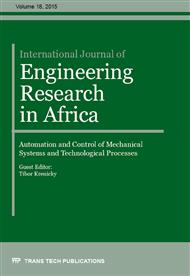[1]
M. More, O. Líška, Design of active feedback for rehabilitation robot, Applied Mechanics and Materials 611 (2014) 529-535.
DOI: 10.4028/www.scientific.net/amm.611.529
Google Scholar
[2]
A. Hošovský, K. Židek, Experimental validation of nominal model characteristics for pneumatic muscle actuator, Applied Mechanics and Materials 460 (2014) 1-12.
DOI: 10.4028/www.scientific.net/amm.460.1
Google Scholar
[3]
B. Jobbágy, J. Karchňák, D. Šimšík, Rehabilitation robotics and wearable sensors as trends of home rehabilitation, in: Proc. of 15th Int. Carpathian Control Conf. ICCC 2014, Velke Karlovice, IEEE, 2014, pp.219-222.
DOI: 10.1109/carpathiancc.2014.6843600
Google Scholar
[4]
A. Hošovský: The control if the PAM-based position servosystem with acceleration loop, Journal of applied science in the thermodynamics and fluid mechanics 2/1 (2008).
Google Scholar
[5]
J. Piteľ, M. Balara, J. Boržíková, Control of the Actuator with Pneumatic Artificial Muscles in Antagonistic Connection, Transactions of VŠB – Technická univerzita Ostrava 53/2 (2007) 101-106.
Google Scholar
[6]
D. Šimšík et al., Design of inertial module for rehabilitation device, in: Proc. of 11th Int. Symp. on Applied Machine Intelligence and Informatics - SAMI 2013, Herľany, Slovakia, IEEE, 2013, pp.33-36.
DOI: 10.1109/sami.2013.6480991
Google Scholar
[7]
J. Piteľ, Modelling of the PAM Based Antagonistic Actuator, information on www. cybletter. com/index. php?s=file_download&id=56.
Google Scholar
[8]
A. Hošovský et al., Model-based Evolution of a Fast Hybrid Fuzzy Adaptive Controller for a Pneumatic Muscle Actuator, International Journal of Advanced Robotic Systems 9 (2012) 1-11.
DOI: 10.5772/50347
Google Scholar
[9]
O. Líška, M. More, D. Janáčová, H. Charvátová, Design of Rehabilitation Robot Based on Pneumatic Artificial Muscles, in: Proc. of 1st Int. Conf. on Optimization Techniques in Engineering (OTENG '13), WSEAS Press, Istanbul, 2013, pp.151-154.
Google Scholar
[10]
A. Hošovský, M. Havran, Dynamic Modeling of One Degree of Freedom Pneumatic Muscle-Based Actuator for Industrial Applications, Tehnički Vjesnik 3/19 (2012) 673-681.
Google Scholar
[11]
K. Židek, O. Líška, V. Maxim, Rehabilitation Device Based on Unconventional Actuator. Mechatronics: Recent Technological and Scientific Advances, Springer, Berlin, 2011, pp.697-702.
DOI: 10.1007/978-3-642-23244-2_84
Google Scholar
[12]
J. Mižáková, J. Piteľ and M. Tóthová, Pneumatic Artificial Muscle as Actuator in Mechatronic System, Applied Mechanics and Materials 460 (2014) 81-90.
DOI: 10.4028/www.scientific.net/amm.460.81
Google Scholar
[13]
J.M. Hopen, A. Hošovský, The Servo Robustification of the Industrial Robot, Annals of DAAAM 2005, DAAAM International, Vienna, 2005, pp.161-162.
Google Scholar
[14]
M. Tóthová, Modeling and Simulation of Dynamics of Nonconventional Pneumatic Actuator of Manipulator - Dissertation Work, TUKE, Prešov, (2014).
Google Scholar
[15]
M. Tóthová, Simulation Model of Pneumatic Actuator Based on Artificial Muscles, in: Proc. of Conference IMAP 2013, TUKE, Prešov, 2013, pp.65-69.
Google Scholar
[16]
M. Tóthová, Simulation of Pneumatic Muscle Actuator Dynamics, in: Proc of 1st Biannual Comparative European Research Conference (CER 2014), London, 2014, pp.109-112.
Google Scholar
[17]
M. Tóthová, A. Hošovský, Dynamic Simulation Model of Pneumatic Actuator with Artificial Muscle, in: Proc. of 11th IEEE International Symposium on Applied Machine Intelligence and Informatics (SAMI 2013), IEEE, Budapest, 2013, pp.47-51.
DOI: 10.1109/sami.2013.6480994
Google Scholar
[18]
M. Tóthová, Simulation of the Pneumatic Actuator with Artificial Muscles Using Modified Hill´s Muscle Model, in: Proc. of Automation in Theory and Practice (ARTEP 2013), TUKE, Košice, 2013, 41/1-41/8.
Google Scholar
[19]
M. Tóthová, Simulation of the Pneumatic Actuator Dynamics Using Advanced Geometric Model of Artificial Muscle, in: Proc. of Automation in Theory and Practice (ARTEP 2014), TUKE, Košice, 2014, 22/1-22/8.
Google Scholar
[20]
I. Mack et al., Interactive Force Sensing Feedback System for Remote Robotic Laparoscopic Surgery, in: Haptic Audio visual Environments and Games, 2009, information on: http: /ieeexplore. ieee. org/stamp/stamp. jsp?tp=&arnumber=5356129.
DOI: 10.1109/have.2009.5356129
Google Scholar
[21]
T. Kelemenová et al., Model based design and HIL simulations, American Journal of Mechanical Engineering 1 (2013) 276-280.
Google Scholar
[22]
A. Erwin et al., Interaction Control For Rehabilitation Robotics via a Low-Cost Force Sensing Handle, in: Proc. of the Dynamic Systems and Control Conference DSCC 2013, information on: http: /mahilab. rice. edu/sites/mahilab. rice. edu/files/publications/DSCC2013-4073. pdf.
Google Scholar
[23]
A. Hošovský, K. Židek, Experimental Validation of Nominal Model Characteristics for Pneumatic Muscle Actuator, Applied Mechanics and Materials 460 (2014) 1-12.
DOI: 10.4028/www.scientific.net/amm.460.1
Google Scholar
[24]
M. Tóthová, S. Hrehová, Dynamic Characteristics of the Antagonistic Pneumatic Muscle Actuator for Biomechanical Applications, in: Proc. of 2nd Int. Conf. on Sensors and Materials Manufacturing Science (ICSMMS 2015), BOSI EDU, Paris, (2015).
Google Scholar
[25]
A. Hošovský, P. Michal, M. Tóthová, O. Biroš, Fuzzy Adaptive Control for Pneumatic Muscle Actuator with Simulated Annealing Tuning, in: Proc. of 12th IEEE Int. Symp. on Applied Machine Intelligence and Informatics (SAMI 2014), IEEE, Budapest, 2014, pp.205-209.
DOI: 10.1109/sami.2014.6822408
Google Scholar
[26]
J. Boržíková, M. Balara, Mathematical Model of Contraction Characteristics of the Artificial Muscle, Manufacturing Engineering 6/2 (2007) 26-29.
Google Scholar
[27]
M. Balara, M. Tóthová, Static and Dynamic Properties of the Pneumatic Actuator with Artificial Muscles, in: Proc. of IEEE 10th Jubilee Int. Symp. on Intelligent Systems and Informatics (SISY 2012), IEEE, Subotica, 2012, pp.577-581.
DOI: 10.1109/sisy.2012.6339483
Google Scholar
[28]
K. Židek, A. Hošovský: Wireless Device Based on MEMS Sensors and Bluetooth Low Energy (LESmart) Technology for Diagnostics of Mechatronic Systems, Applied Mechanics and Materials 460 (2014) 13-21.
DOI: 10.4028/www.scientific.net/amm.460.13
Google Scholar
[29]
P. Berkelman et al., A Miniature Microsurgical Instrument Tip Force Sensor for Enhanced Force Feedback During Robot-Assisted Manipulation, in: IEEE Transactions On Robotics And Automation, 2003, information on: http: /www. cs. jhu. edu/~rht/RHT%20Papers/2003/Miniature. pdf.
DOI: 10.1109/tra.2003.817526
Google Scholar
[30]
A. Erwin et al., Interaction Control For Rehabilitation Robotics via a Low-Cost Force Sensing Handle, in: Proc. of the Dynamic Systems and Control Conference DSCC 2013, information on: http: /mahilab. rice. edu/sites/mahilab. rice. edu/files/publications/DSCC2013-4073. pdf.
Google Scholar
[31]
F. Trebuňa, P. Sivák, Experimental methods of thermomechanics: Tensometry (Experimentálne metódy mechaniky: Tenzometria), TUKE, Košice, 2012 (in Slovak).
Google Scholar


